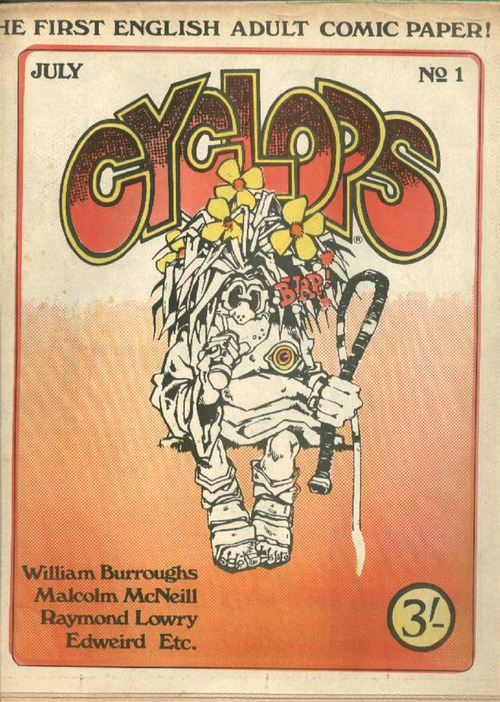
All images © Malcolm Mc Neill unless otherwise indicated (Lost Art of Ah Pook Is Here, 166)
Adrian Hill on Malcolm Mc Neill and William S. Burroughs’s Ah Pook Is Here
The following is a three part exploration of Malcolm Mc Neill and William S. Burroughs’ word-image collaboration during the 1970s. This is the first part, check back next Tuesday for part two.
Ah Pook Is Still Here
On December 22, 2012, I typed an online comment on The Comics Journal website, underneath Rudy Rucker’s review of Malcolm Mc Neill’s The Lost Art of Ah Pook and Observed While Falling: Bill Burroughs, Ah Pook, and Me. The two books detail a word-image collaboration that was never completed between Mc Neill, a painter and illustrator, and William S. Burroughs—on a project called Ah Pook is Here. Observed While Falling is a written memoir and The Lost Art of Ah Pook is a visual record of their unfinished project’s progression.
This was my comment:
I just finished reading “Observed While Falling”, and am happy to report that I can’t remember the last time a book fucked me up so much – in the best sense of the expression. I bought a copy after reading this review. Without knowing any more about it, I ended up reading the bulk of the book on Dec. 21…read it and you’ll understand.
I’m imagining someone out there scanning the complete text of Ah Pook is Here and Other Texts as I write this post, in the interests of disseminating a copy freely and widely. Copyright and the Burroughs Estate be damned.
I think Bill would approve.
Burroughs’ writing is at times almost impossible to comprehend without a guide, despite the fact the text of Ah Pook is Here is actually one of Burroughs’ more linear works of fictional prose. By contrast, Mc Neill’s account of his time with Burroughs is also challenging, but, at the same time, succinct, and digestible.
Burroughs’ aesthetic philosophy extends beyond comics, to the relationship between words and pictures in the text, and generally—their contribution to how we perceive the world, and how equally we are limited by those perceptions. What is most remarkable about Burroughs’ insights, and Mc Neill’s ability to describe and render them explicit through his art and descriptions, is that these explorations were conducted over thirty years ago.
I started reading Observed While Falling again. I took notes, transcribing whole passages from the book in an attempt to unearth some deeper understanding of Burroughs’ cosmology, but also to figure out why Mc Neill’s books resonated so strongly with me.
One day, I came home from work and a letter had arrived from Malcolm Mc Neill himself. He had sent the letter in regards to my comment on the Comics Journal website: Mc Neill mentioned that when he was growing up, he used to watch a how-to-draw television program by the artist Adrian Hill. That’s what led him to my comment. He was supportive: “A book that fucks someone up in the best way is truly an encouragement.”
Ah Pook is Here—as it was originally conceived—constitutes an early predecessor of the “graphic novel” format, and is only now being fully brought to light. Even by today’s standards, Mc Neill’s half of the Ah Pook equation constitutes a boundary-blurring experiment in extended graphic narrative.
The Unspeakable Mr. Hart
Mc Neill graduated from the Graphics program at Hornsey College of Art in 1970. One of his final papers was about “Visual Narrative,” a history of the process of using images to tell a story; from the Egyptians, Greeks, Romans and Maya and up to the present day Sunday Funnies (OWF, 14). Considering that Scott McCloud’s Understanding Comics (1993) only recently introduced these ideas to the popular imagination, one gets an idea of how progressive Mc Neill’s thinking was even as a young artist.
Following graduation, Mc Neill worked on personal projects that he describes as “self-contained narrative episodes in the form of freestanding paintings” (OWF, 15). He came up with the idea of publishing Cyclops, a magazine of anthologized British comics created in the same spirit as American underground comix. Mc Neill eventually worked on the project with Graham Keen—the graphics editor for London’s underground newspaper the International Times—who suggested that Mc Neill provide a visual interpretation of a text being supplied by Burroughs on a monthly basis, called “The Unspeakable Mr. Hart.” Mc Neill had never met Burroughs and knew little about him.

Cyclops #1, Cover by Malcolm Mc Neill
The strip was discontinued after four installments, but Mc Neill’s work on “The Unspeakable Mr. Hart” led to Burroughs insisting that he meet the artist; Burroughs noticed an uncanny resemblance between Mc Neill’s drawings of Mr. Hart and his own physical characteristics. For Burroughs, it was a sign. By the end of their first meeting, Burroughs and Mc Neill were discussing working with one another on a new creation, potentially on a scale much grander both physically and artistically: it was the birth of Ah Pook is Here.
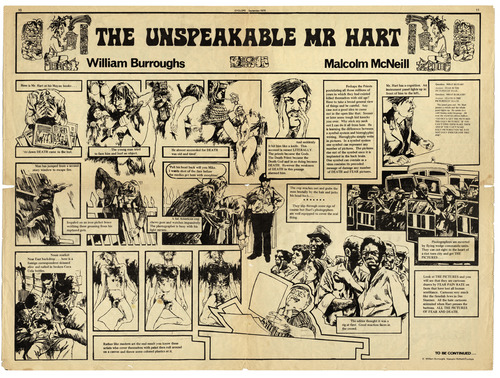
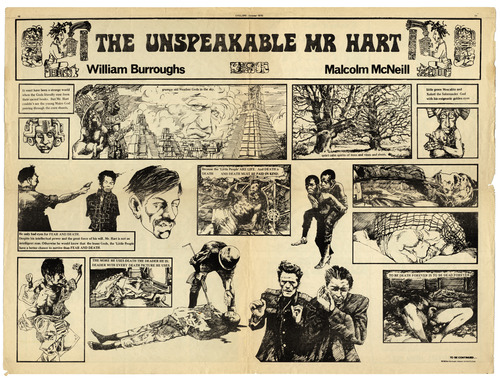
The Word/Image Track
Mc Neill’s stylistic choices for Ah Pook drew from two parallel inspirations: the visual imagery of “The Garden of Earthly Delights” by Hieronymus Bosch, and images from the Dresden Codex, housed within the British Museum. Mc Neill and Burroughs visited the museum and studied the codex together, even procuring a photocopy of it, which in those days was very difficult.
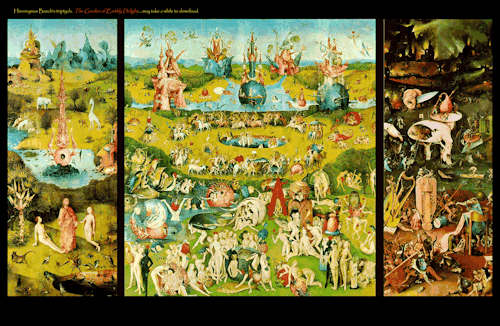
“The Garden of Earthly Delights” by Hieronymous Bosch
As Burroughs wrote, Mc Neill drew. The disparate concepts explored in Ah Pook—and the fact that it remained a dynamic text during Mc Neill’s art production—led to the development of a unique methodology and presentation format:
The style of the artwork made it difficult to alter and since the text was continually subject to change, I was reluctant to commit to finished pages. I began to create frames individually with the intention of assembling them once everything was complete. This led to the idea of the book as a single image: a continuous panorama, something completely in keeping with the Mayan Codices (OWF, 41).

Salomon Arts Gallery, New York City
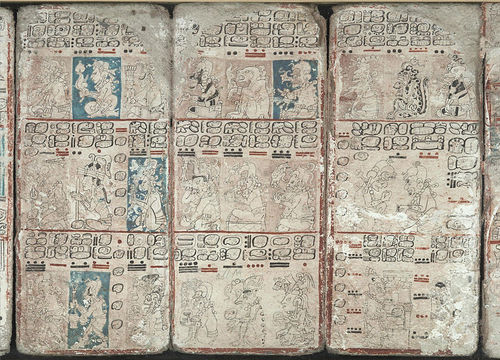
The Dresden Codex, pages 6-8. Full codex available here.
The Burroughs and Mc Neill collaboration was an attempt, literally and figuratively, to “cut the word lines” of what Burroughs described as the word/image track. It was a summoning of Ah Pook, the Mayan god of death and destruction, into the modern world.
Burroughs was convinced that a record of past, present and future reality exists as a kind of script acted out through time and space. By perforating the “word/image track”—the holes in that continuum allow us to glean insights into events from other time periods, a form of prescience or retrocognition. The nature of coincidence constitutes an alignment between these events and our position in relation to them.
According to Burroughs, one way of encouraging these association lines to reveal themselves is through the seemingly random manipulation of text to make new meanings. The painter Brion Gysin is attributed with having first discovered the “cut-up” technique through which these meanings become apparent. Burroughs quickly adopted cut-ups as a primary method for composing his works. The approach was inspired in part by the “cadavre exquis” (exquisite corpse) exercise first realized by the surrealists, who Gryson knew at one point in his early adulthood.
Burroughs and Mc Neill challenged the limits of the forms in which they were operating:
Apart from the instant dismissal the word “comic” tended to evoke from publishers, lines around things restricted the kind of images I was able to produce—particularly with regards [to] depth and light. They were also contrary to the very idea of Ah Pook (39).
Breaking down the traditional frame-by-frame visual narrative into a representation with permeable borders allowed Mc Neill to work on pages in any order he chose:
Thinking of Ah Pook in this way opened up a new way of perceiving a book, and reduced the difficulties inherent in an evolving script. Most significantly, it meant I was no longer confined to a particular order when producing the images.
A true panorama is an image extended horizontally in order to achieve a complete 360-degree point of view. An image that, in effect, has no beginning or end. It was a design concept that corresponded perfectly with the ongoing, reciprocal nature of Ah Pook. By creating frames from whichever part of the book I felt like, I was also in sync with the concept of the book: breaking down the word/image track and traveling back and forth in time.
The book was designed to reflect the structure of a codex with the image narrative taking place within conventional frames. When there was conflict in the story, however, this ordered structure also broke down, allowing for a free-form kind of imagery unrestrained by either frames or the edges of pages. To suggest that such chaos was always imminent, ‘time holes’—irregularly shaped sections of images from elsewhere in the book—floated randomly throughout. Mayan gods who’d escaped from Hart’s books also wandered through the images both inside and outside of the frames: sometimes participating in the story, sometimes not. Mayan glyphs accompanied them, evoking Bill’s notion of word as virus. (OWF, 40).
Mc Neill did not depend entirely on Burroughs’ text as the driver for his artwork. He propelled the storyline by creating an allegorical framework of his own—for example, within which bats morph into butterflies as a vehicle for the passage of time. Mc Neill explains in an interview from The White Review:
The images would not be constrained by the edges of the pages either. At the end it amounted to scenes flowing from one time zone to another. I needed a device to get from Armageddon to the first evolutionary change and came up with ‘bats out of hell’. I filled the bat shapes with the incoming scene, which in turn used birds to get to the next. The last was to be the release of the butterflies of fear, which would lead into the Garden of Delights. These weren’t in the script obviously, but Bill was more than happy with the results. The random juxtaposition of incoming and outgoing images in effect corresponded to his Cutup methodology.
Control
Though Ah Pook is Here was originally conceived as a graphic narrative, Mc Neill’s illustrations were never published simultaneously with the text—with the exception of a twelve page excerpt published in Rush magazine in December 1976 (LAAP, 152). Rush was a “marijuana advocacy” magazine published by the Swank Magazine Corporation, publishers of the porn magazine Swank.
When Burroughs moved out of his Franklin Street loft in New York in 1975, he agreed to pass the loft on to Mc Neill. James Grauerholz, the executor of Burroughs’ estate whom Burroughs later adopted as a son, was about the same age as Mc Neill, and by this time was solidly established as Burroughs’ personal secretary. Grauerholz insisted to Mc Neill that Burroughs had not been in his right mind when he made the offer of the loft, suggesting that Burroughs had been “tripping.” When Mc Neill later confronted Grauerholz about the discrepancy between the two accounts, Mc Neill reports, “his response was remarkably candid”:
“I admit I’ve gone out of my way to obstruct you on occasions,” he said. “I put it down to sibling rivalry.” (OWF, 75).
Without the publication of Mc Neill’s illustrations along with the Ah Pook is Here manuscript, his contribution to the Burroughs legacy has remained largely undocumented, up until the Fantagraphics release of Mc Neill’s works. When John Calder published Ah Pook is Here and Other Texts in 1979, none of Mc Neill’s artwork accompanied Burroughs’ prose. This included Mc Neill’s original cover image for Ah Pook is Here, which Grauerholz replaced with a new cover designed by Brian Paine.
Burroughs, however, did add an acknowledgment of Mc Neill’s contribution to the book’s preface:
Ah Pook is Here was originally planned as a picture book modelled on the surviving Mayan codices. Malcolm McNeill [sic] was to do the illustration, and I was to provide the text. Over the years of our collaboration there were a number of changes in the text, and Malcolm Mc Neill produced more than a hundred pages of artwork. However, owing partly to the expense of full-color reproduction, and because the books [sic] falls into neither the category of the conventional illustrated book nor that of a comix publication, there have been difficulties with the arrangements for the complete work—which calls for about a hundred pages of artwork with text (thirty in full-color) and about fifty pages of text alone.
The book is, in fact, unique. Some pages are entirely text, some entirely pictorial, and some mixed. Finally Malcolm Mc Neill and I have decided to publish the text without the artwork, still in hopes of seeing the eventual publication of this work that has been eight years in preparation (APIHOT, 11).
William S. Burroughs
27 April 1978

1979 Calder edition of Ah Pook is Here and Other Texts. Cover design by Brian Paine (glyph of Ah Puch from the Dresden Codex)
The Publishing Game
Reality Studio: A William S. Burroughs Community includes passages from a 1972 Rolling Stone interview, a 1973 BBC interview, and Burroughs’ essay, “Les Voleurs” (from The Adding Machine: Collected Essays, John Calder, 1985) in which Burroughs mentions working with Mc Neill on an important new project.
In the essay, “Ah Pook is Where?” by Sara Van Ness—an insightful critical addition to The Lost Art of Ah Pook is Here—Van Ness suggests that one of the reasons publishers shied away from printing Mc Neill’s artwork was not just due to its pornographic imagery, but also because the work fit neither within the genres of straight pornography, nor the comic book.
Even though publishers would not print the book in its originally conceived form, why is there only one sparse reference to Mc Neill in Burroughs’ life and artistic development in Ted Morgan’s biography of William S. Burroughs, Literary Outlaw? I posed the question to Mc Neill whose response, in a nutshell, boiled down to one sentence: “It was always a mystery.”
When the biography was republished in 2012, even with Morgan’s awareness that Observed While Falling and The Lost Art of Ah Pook were being published, no changes had been made to Burroughs’ biography. The publisher requested asked that Morgan write a new introduction and final chapter to the volume but asked that no further changes be made to the text of the biography in the new edition. Even in Barry Miles’ more recent (2014) authorized biography, Call Me Burroughs: A Life, there is little mention of the Mc Neill-Burroughs collaboration, and no explanation for why the text ended up being printed without Mc Neill’s images.
At the time when Mc Neill approached James Grauerholz about publishing Observed While Falling, “James was now lecturing in American Studies at the University of Kansas. He’d finally put to rest any idea of sibling rivalry by becoming Bill’s legally adopted son and was sole heir to Bill’s entire creative legacy” (OWF, 142).
In spite of this claim, when Grauerholz read through an early draft of Observed While Falling, Mc Neill was asked to “revisit” his memory and rewrite elements of his memoir to portray Grauerholz in a more positive light. Mc Neill conceded. Why then, were negotiations stalled indefinitely when Mc Neill requested to reproduce excerpts of the text of Ah Pook is Here? No explanation was offered by either Grauerholz or Jeffrey Posternak of the Wylie Agency, Burroughs’ publishing agent.
Gary Groth and Mc Neill had initially suggested republishing the Calder edition of Ah Pook is Here as a standalone text, but this suggestion was refused. Grauerholz asked for Observed While Falling to not be published at all. In addition, he suggested that he could edit the originally approved Calder version of Ah Pook is Here if a new version were to be released—both requests that Mc Neill flatly turned down. At this point, Grauerholz broke off all communications with Mc Neill and Groth. With negotiations at a standstill, Mc Neill chose to revert to his original version of Observed While Falling.
“Cut the word lines and the future leaks out.”
The Third Mind by Burroughs and Brion Gryson suggests that cut-ups are a gateway to understanding reality through action. The cut-up is something anyone can do. Cut-ups are experiential in nature, and since anyone can do them, they level the playing field: they offer anyone access to a revelatory psychic space. Burroughs suggests that all too often we are neither conscious of how we use words, nor of their effects on our surroundings. Cut-ups allow us to realize that the universe is infused with meaning; all we need to do is look for the signs.
In The Third Mind, Burroughs explains that his point of entry into fiction is the dream: “Precisely what is a dream? A certain juxtaposition of word and image.” Burroughs’ preoccupation with words led him to questioning their very role in human experience. As Mc Neill explains:
“Nobody seems to ask the question what words actually are…” [Burroughs] once remarked. “… and what exactly their relationship is to the human nervous system.”
[Burroughs] viewed them as energy—organic, even—and subjected them to laboratory-like scrutiny, relentlessly prodding at them and dissecting them to try and elicit a response—to try and determine patterns of behaviour. His m.o. [modus operandi—“method”] as a writer might be described as the process of using words to see what words can do (OWF, 44).
Further to this notion, Burroughs suggested, “The purpose of writing is to make it happen” (OWF, 44). The analogy between words and organic life led to Burroughs’ contention that language is a virus, its only end being to reproduce itself—though Burroughs had other reasons to “write his way out.”

(LAAP 106-108)
“Nothing is true, everything is permitted.”
Burroughs’ writing in Ah Pook is Here was partially informed by an avid interest in the Mayan codices. Joan Vollmer (Burroughs’ wife) initially turned him onto the Mayans. (It is worth noting that prior to and even during his marriage, Burroughs also had multiple gay lovers, and would swear off women almost completely following Vollmer’s death). Vollmer believed that Mayan priests had the ability to practice telepathy.
Burroughs is probably almost as well known for his writing as for the fact that he killed Vollmer by firing a gun into her temple, ostensibly aiming for a shot glass that she had placed on her head in a spontaneous reenactment of the “William Tell routine.” The exact details of the events surrounding Vollmer’s death are uncertain, and have been documented in “The Death of Joan Vollmer Burroughs: What Really Happened?” by James Grauerholz.
In a famous passage from the introduction to Queer, Burroughs explains the impact of Joan Vollmer’s death at his hands in terms of his writing:
I am forced to the appalling conclusion that I would never have become a writer but for Joan’s death, and to a realization of the extent to which this event has motivated and formulated my writing. I live with the constant threat of possession, from Control. So the death of Joan brought me in contact with the invader, the Ugly Spirit, and maneuvered me into a lifelong struggle, in which I have had no choice except to write my way out (LO, 199).
Burroughs’ interest in systems of control is said to have originated with Brion Gysin’s fascination with Hassan I Sabbah. Ted Morgan suggests that Hassan I Sabbah “…devised the maxim ‘Nothing is true, everything is permitted,’ and lived up to it, recruiting political assassins who were fed hashish for motivation” (LO, 305). Morgan’s attribution of the quote to Hassan I Sabbah has since been challenged, as has Burroughs’ description of Sabbah as “the Old Man of the Mountain” (OWF, 180). Be that as it may, Burroughs was especially taken with the Persian leader’s supposed dictum, as well as the element of control inherent in Hassan I Sabbah’s purported ability to rule over a group of ruthless killers through regularly administering them mind-altering drugs.
Burroughs’ Cities of the Red Night begins with an “Invocation” that dedicates the book to Hassan I Sabbah and Ah Pook among others. As Mc Neill describes in Observed While Falling, Cities of the Red Night also notably includes a passage that describes a collaborative process strikingly resembling the one utilized by Mc Neill in the creation of images designed to accompany the text of Ah Pook is Here. And the book includes a character assuming the role of Ah Pook, fucking a young Corn God, spreading death and decay amongst the passengers on a Spanish galleon when they come—standard Burroughs fare, and a nod to ideas originally conceived in Ah Pook is Here.
Before and After
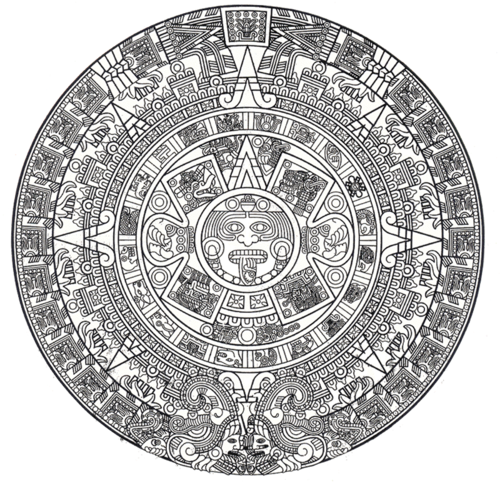
A year passes, and world still remains intact.
In the Classic period of Mayan civilization, dates were tracked according to what is described as the Long Count.
In the traditional Mayan calendar, there are 18 20-day months in a year.
Each of these months is a katun.
One year is calculated as 360 days, or one tun.
A period of twenty tuns is called a baktun: 400 years.
In addition to this straightforward counting method, Mayan timekeepers also used an almanac on a cycle of 260 days, the tzolkin (“count of days”) to inform horoscopes and crop predictions, as well as recording astronomical patterns with an accurate solar calendar.
One katun cycle is 20 tuns, or 7200 days. The katun cycle is significant in that mathematically, it is also the point of convergence with the tzolkin cycle of 260 days, in that both are divisible by twenty, and there are 20 days in a katun: 13 katuns equals one tzolkin.
In the tzolkin, the beginning of the most recent baktun is dated at 1618, and its end is calculated as December 21, 2012. The date’s significance as the end of the world is a fabrication of western New Age spiritualists, for in the Mayan worldview, the Long Count has no beginning and no end.
In the same way that the English names of the days of the week originate with the names of the Norse gods (with the exception of Saturday), “every unit of time was a numinous being, influenced by many divinities, and a divinity in itself.” The quality of any given day (in spiritual terms) is determined by the interaction of the various divinities at play, among other factors:
For the Maya nothing happens purely by chance. There are influences at work in everything: the weight of the number; the character of the day; the character of the year in which the day falls. Added to these are the positions of the planets, the phase of the moon, the earthly seasons of rain and heat (TAM, 247).
In all of the Maya languages, the word for “sun” also means “day” and “time.” Wright, quoting Mexican scholar León-Portilla explains:
“The Maya conceived of time in close association with the solar deity, something divine in itself, limitless and ubiquitous.” Time animates, and is indivisible from, space: “All the deities present and acting in space are the changing countenances of time. Isolated from time, space becomes inconceivable. In the absence of time-cycles, there is no life, nothing happens, not even death” (TAM, 249).
Following the Classic period of the Mayans, the recording of the 400-year baktuns was abandoned, with the 20-year katuns repeating themselves indefinitely, though they were still attached to the 260-day tzolkin cycle. This new timekeeping method is known as the Short Count. Ronald Wright explains the relationship between the Long Count and the Short Count as follows:
Because the tzolkin, like the Old World zodiac, influenced destiny, the Maya thought that katuns bearing the same sequence—were fated to hold similar events. Past and future became structured in a symmetrical relationship; history became prophecy; and prophecies became self-fulfilling because actions were apparently undertaken to coincide with the appropriate date. Having lost the statelier rhythms of the Long Count, the Maya were trapped in whirlpools of calendric destiny.
For them, as for T.S. Eliot in The Four Quartets:
Time present and time past
Are both perhaps present in time future,
And time future contained in time past (TAM, 75-76).
Exploring Inner Space
William S. Burroughs reached similar conclusions to the Mayans concerning the nature of time in his travels as “a mapmaker, charting unexplored areas of the psyche” (OWF, 134)—in particular with the consumption of the hallucinogenic brew called yagé (also known as ayahuasca) by brujos, or medicine men. Yagé is concocted predominantly by the indigenous peoples of Peru. Burroughs spent time in the region with the explicit purpose in mind of seeking out the drug. In a letter to Allen Ginsberg (July 10, 1953), Burroughs wrote, “Yagé is space time travel. The room seems to shake and vibrate with motion.” He further explained:
The Indians call yagé a Soul Vine and it is used by medicine men to potentate their psychic powers. After taking yagé they allegedly can locate lost or stolen objects, read the thoughts of others, diagnose disease, foresee the future, and obtain knowledge of distant objects and events (YLR, 90).
Ethnobotanical researcher Steve Beyer has quoted Burroughs in a letter to Allen Ginsberg explaining in 1955, “The meaning of Interzone, its space time location is at a point where three-dimensional fact merges into dream, and dreams erupt into the real world.”
Beyer describes this zone as “the world of the shaman—the vision, the apparition, the lucid dream, seeing through the ordinary to the miraculous luminescence of the spirits, perceiving the omnipresent pure sound of the singing plants.”
Mc Neill has similarly described the Mayan preoccupation with time as one example in “…a long record of shamans, mystics, seers, prophets, psychics, and clairvoyants [which] reveals a propensity that has conceivably existed since humans became conscious of time” (OWF, 114).
Burroughs and Mc Neill may be perceived as descendants situated from within this lineage, though both would most likely classify themselves as spiritual “independents.” Mc Neill’s studies in the practice of attention suggest that by asking the right questions in any given situation, an increased awareness of the information at one’s disposal can be cultivated (OWF, 148). By extension, with the increase in access to information worldwide through digital networks, Mc Neill posits that there will follow an increase in the human realization of coincidence.
Compared with other forms of symbolic interpretation, for example tea leaf or hexagram readings, Mc Neill suggests that words provide immediate access to an understanding of future events:
It’s a form of augury that literally cuts to the chase. Random rearrangements of cards, coins, dice, bones, animal guts, etc. require interpretation. With words, the meaning is direct. You have the answer in writing. Future events can be held accountable to their word. Given that such accountability does occur, the concept of life as pre-recorded script gains credence (OWF, 115).
Words can in fact be fragile, duplicitous and disingenuous. If you agree with Mc Neill that the meaning of words is direct, then it’s fair to posit that by extension, the possibility of a correspondence between events as they may be “pre-recorded” within the word/image track and present-day occurrences may be realized. But how much of a word’s interpretation relies on the webs of significance within which a subject resides, and how much does a subject’s context impact accountability? The inherent circularity and solipsism that this view implies leaves room at the very least for radical philosophical scepticism.
In an article written by Burroughs for Crawdaddy magazine based on meetings between Burroughs and Led Zeppelin’s Jimmy Page, Burroughs states, “If you consider any set of data without a preconceived viewpoint, then a viewpoint will emerge from the data.” The information’s all there—it just needs to be aggregated and analyzed into meaningful forms. Mc Neill suggests:
…The patterns and organizing principles of synchronous events are revealing themselves. If there is a reason above all for acknowledging the events that occurred in Ah Pook is Here, it is to contribute to that endeavour…Hopefully, this book establishes a few more tangible coordinates, a few more dots, for someone else to join (OWF, 134).
As practitioners of magic, both Burroughs and Mc Neill fall outside of any orthodox spiritual institution. Though many of Mc Neill’s associations seem closely aligned to the Jungian notion of synchronicity, no mention is made of a corollary belief in the existence of the collective unconscious or of an essentially archetypal universe. Throughout his life, Burroughs actively sought out ways to try and explain his world, though he tended to selectively adopt findings of the various pseudoscientific frameworks he encountered—including psychoanalysis, Scientology, Wilhelm Reich’s orgone energy treatments, and Alfred Korzybski’s non-Aristotelian general semantics.
In considering the irony involved in Burroughs’ funeral taking place in a traditionally Christian environment, only to be followed up with a Tibetan Nyingma Buddhist bardo ceremony afterwards, Mc Neill pinpoints what he sees as Burroughs’ ideological disposition:
Mixing and matching spiritual conviction in this way suggests an à la carte, more discriminating view of religion. The use of specific ritual, however, contradicts the idea. It succumbs to the same superstition—the same great fear con laid down by organized religions from the get-go. The system of Control and spiritual undermining Bill had condemned throughout his career. As he pointed out in Ah Pook, there are no rules, no procedures, no correct words, for reliably dealing with this life, let alone the next (98).
It’s not a stretch to suggest that by most peoples’ standards even today, Burroughs’ life was highly unconventional. In terms of the psychic space he inhabited, there was little censorship involved in Burroughs’ writing. His ability to question the controlling ethos and orthodoxy of the literati challenged a generation of writers and beyond to think differently about writing.




